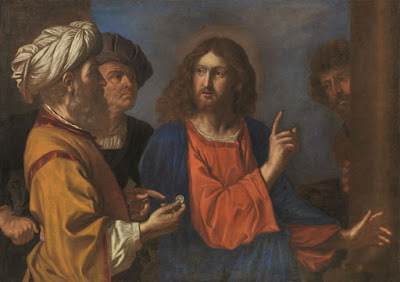 |
| Guercino (Giovanni Francesco Barbieri) Virtuous Love (Cupid spurning Riches) 1654 oil on canvas Museo del Prado, Madrid |
 |
| Guido Reni Cupid 1637-38 oil on canvas Museo del Prado |
"[Guercino's Virtuous Love] is listed by [Carlo Cesare] Malvasia among the 'many commissions for 1654', in this case for an otherwise unidentified 'Padre Salvatore' of Piacenza, whose payment of 10 Spanish doubloons (equal to 38 ½ scudi), plus 25 ounces of lacquer and 21 ounces of lapis lazuli, was recorded on 19 June 1654. Long paired with Guido Reni's similarly sized Cupid [directly above], painted some 18 years earlier and also in the Prado, the two works were documented together in Madrid as early as the inventory of the Alcázar of 1666, when they were hanging in King Philip IV's summer office. Both were presented as gifts to the art-loving Spanish monarch in May 1655 by Cardinal Camillo Massimo, himself a passionate collector who served as papal legate at the Spanish court between 1654 and 1656. The Cardinal may well have ordered Guercino's painting specifically as a pendant for the Reni: he was already in Spain when it was paid for (which also explains the payment in Spanish currency). The purpose of these diplomatic gifts must have been to curry favour with the Spanish king, who had initially refused the Cardinal's appointment as papal nuncio, complaining that he was too friendly with the French (Massimo was indeed an important patron of Poussin and Claude)."
 |
| Guercino (Giovanni Francesco Barbieri) Purification of the Virgin 1654 oil on canvas Chiesa di Santa Maria della Pietà, Ferrara |
 |
| Guercino (Giovanni Francesco Barbieri) Purification of the Virgin 1654 drawing (drapery study - Virgin) Staatsgalerie, Stuttgart |
 |
| Guercino (Giovanni Francesco Barbieri) Purification of the Virgin 1654 drawing (figure and drapery study - Joseph) Staatsgalerie, Stuttgart |
 |
| Guercino (Giovanni Francesco Barbieri) Purification of the Virgin 1654 drawing (head studies - Virgin) Fondation Custodia, Paris |
"A batch of 20 previously unpublished autograph letters, documents and designs, auctioned by Sotheby's, London, in 2004, sheds important light on the commission of [the Purification of the Virgin] – the embodiment of Guercino's dignified, clear and calmly monumental late style – as well as the design and construction of the altar specially built to house it in the Theatine church in Ferrara. . . . The cache of manuscript material included a letter of 1655 to the patron [Claudio] Bertazzoli from Guercino, expressing his hope that the patron would find the work acceptable and informing him that his nephew Benedetto Gennari, also actively involved with the project, would oversee the delivery of the painting to Ferrara and be on hand to make good any damage incurred in transit."
 |
| Guercino (Giovanni Francesco Barbieri) St Sebastian 1654 oil on canvas Museo de Arte de Ponce, Puerto Rico |
 |
| anonymous copyist after Guercino St Sebastian after 1654 oil on canvas Musée des Beaux-Arts, Nantes |
"As explained by Samuel Vitali, it is now thought that the [St Sebastian, above (original and copy)] is one of a pair of half-lengths [with the Sophonisba, directly below], commissioned by the Venetian collector, merchant and art dealer Giovan Donato Correggio (1608-74), mentioned by Malvasia under the year 1654. . . . In 1646, Correggio was accepted as a member of the Venetian nobility. His new social status culminated in the acquisition of a palace on the Grand Canal. Contemporary accounts describe the magnificent picture gallery, devoted mainly to the work of the best Italian painters of the day."
 |
| Guercino (Giovanni Francesco Barbieri) Sophonisba 1654 oil on canvas Schoeppler Collection, London |
 |
| Guercino (Giovanni Francesco Barbieri) Christ and the Tribute Money 1654 oil on canvas Palazzo Durazzo Pallavicini, Genoa |
 |
| Guercino (Giovanni Francesco Barbieri) Martyrdom of St Emerenziana 1654 oil on canvas Palazzo Colonna, Rome |
 |
| Guercino (Giovanni Francesco Barbieri) Martyrdom of St Emerenziana 1654 drawing (compositional study) Nationalmuseum, Stockholm |
 |
| Guercino (Giovanni Francesco Barbieri) Return of the Prodigal Son 1654 oil on canvas Timken Museum of Art, San Diego, California |
 |
| Guercino (Giovanni Francesco Barbieri) St John the Baptist Preaching 1654-55 oil on canvas Pinacoteca Communale, Forlì |
"Of Guercino's many representations of St John in the wilderness, only one other depicts him preaching – the painting of 1641 in the Kunsthistorisches Museum, Vienna. In both, the saint looks out directly at the viewer, one arm raised above his head and pointing to the sky. In the Vienna picture, he is seated and close to the picture plane, filling much of the picture space, while in the altarpiece in Forlì he is much smaller in relation to the compositional space; he half stands and half kneels at a prie-dieu of rock, framed by a great rocky archway, through which can be seen a landscape and a large expanse of sky."
 |
| Guercino (Giovanni Francesco Barbieri) Samson and Delilah 1654 oil on canvas Musée des Beaux-Arts de Strasbourg |
""Charles II Gonzaga, Duke of Mantua had ordered [Samson and Delilah] as a pendant to the Lot and his Daughters [now in the Louvre], which Guercino had sent him in the summer of 1651, paying 555 scudi for the two paintings, after a considerable delay, on 23 December 1657. In the 1990 Guercino exhibition in Paris, the two paintings were shown together. They had remained in the ducal collection at Mantua until 1711, when they appeared on a list of pictures to be sold from the collection; that sale took place c. 1715-20, in Paris and London."
 |
| Guercino (Giovanni Francesco Barbieri) Virgin and Child presenting the Rosary to St Dominic (a fragment of the painting survives in a private collection) 1655 drawing (compositional study) Musée du Louvre |